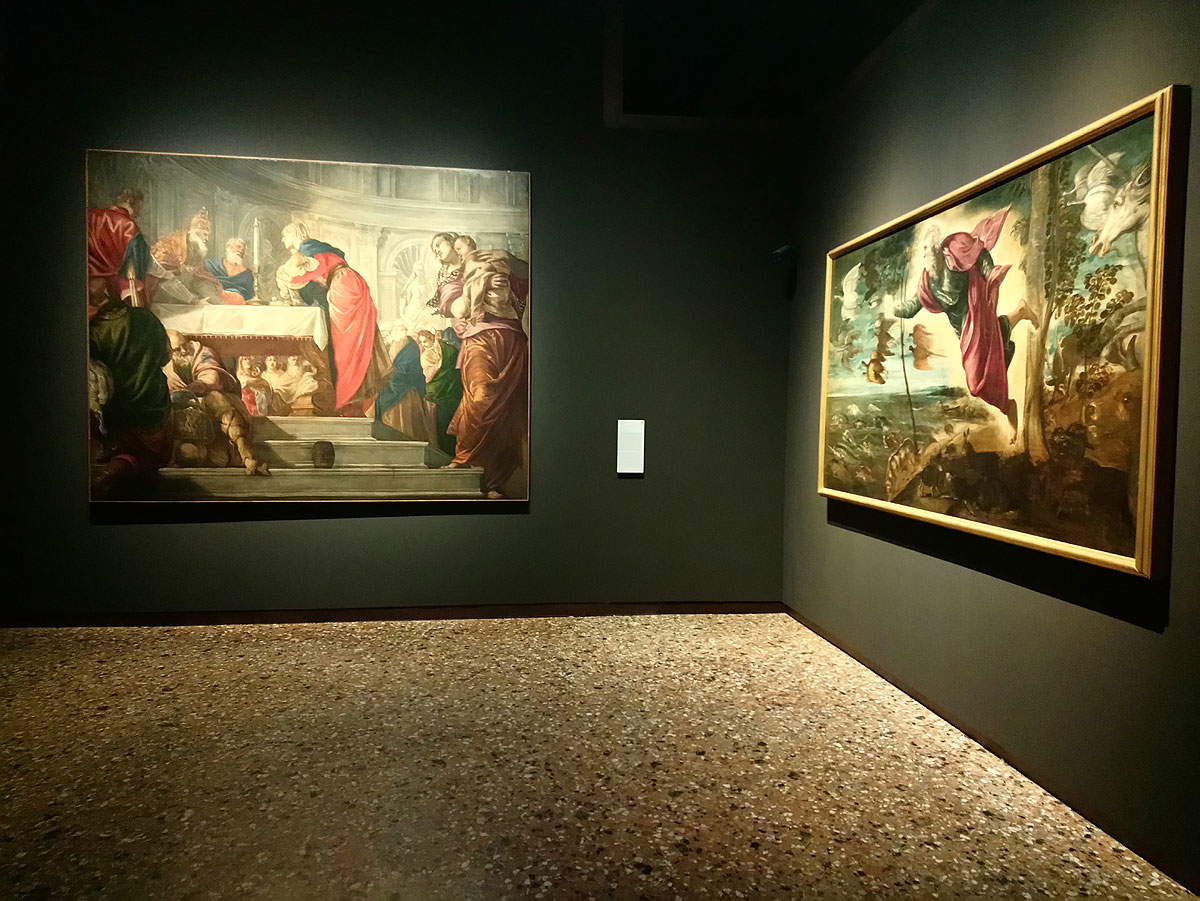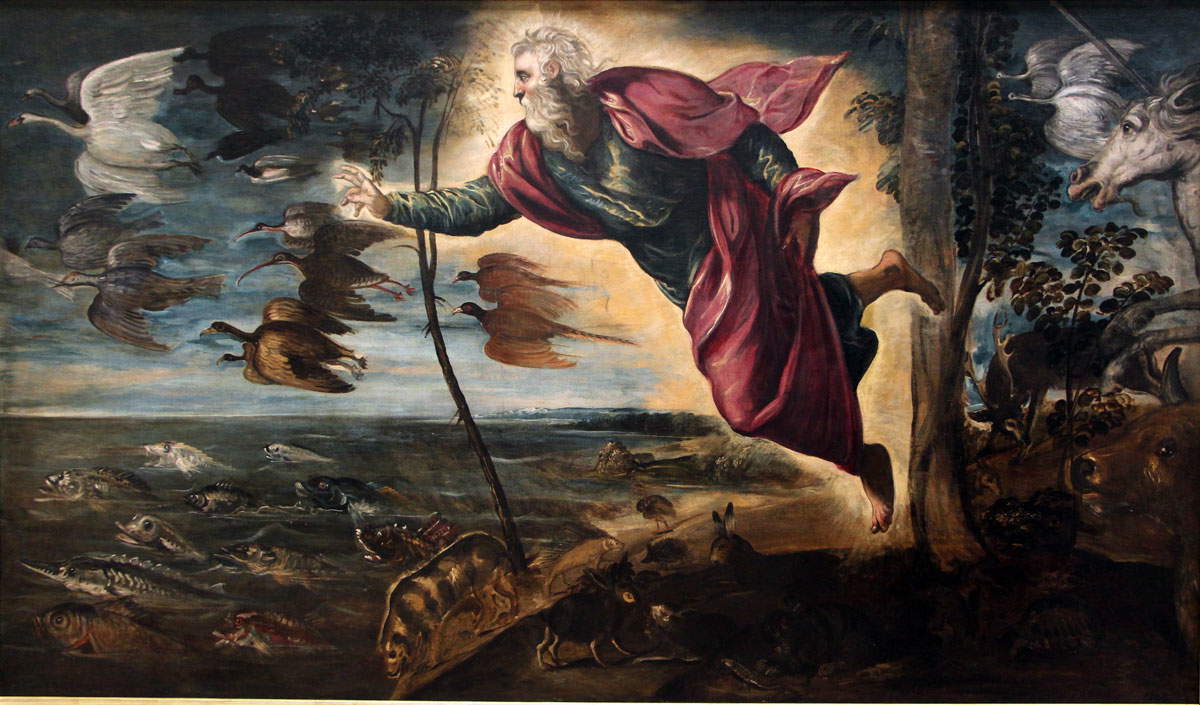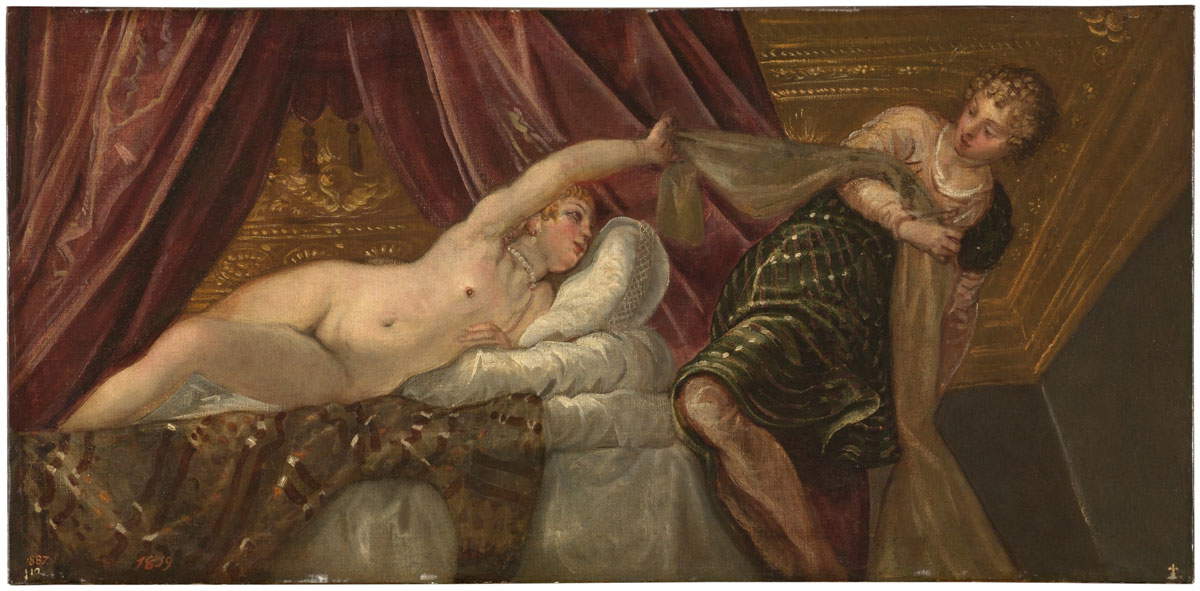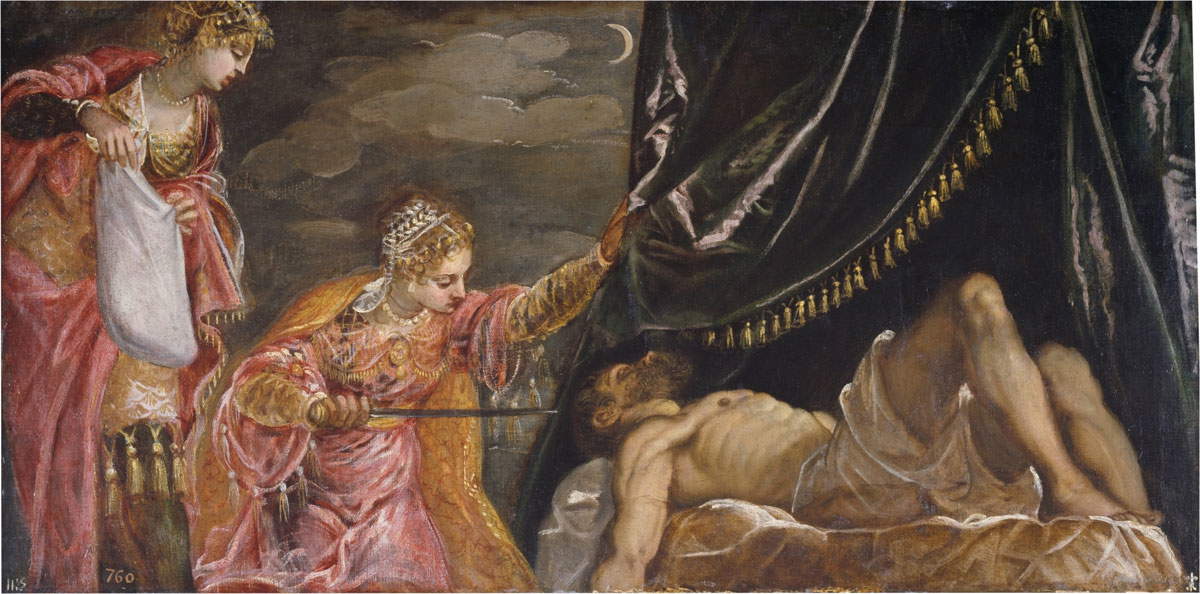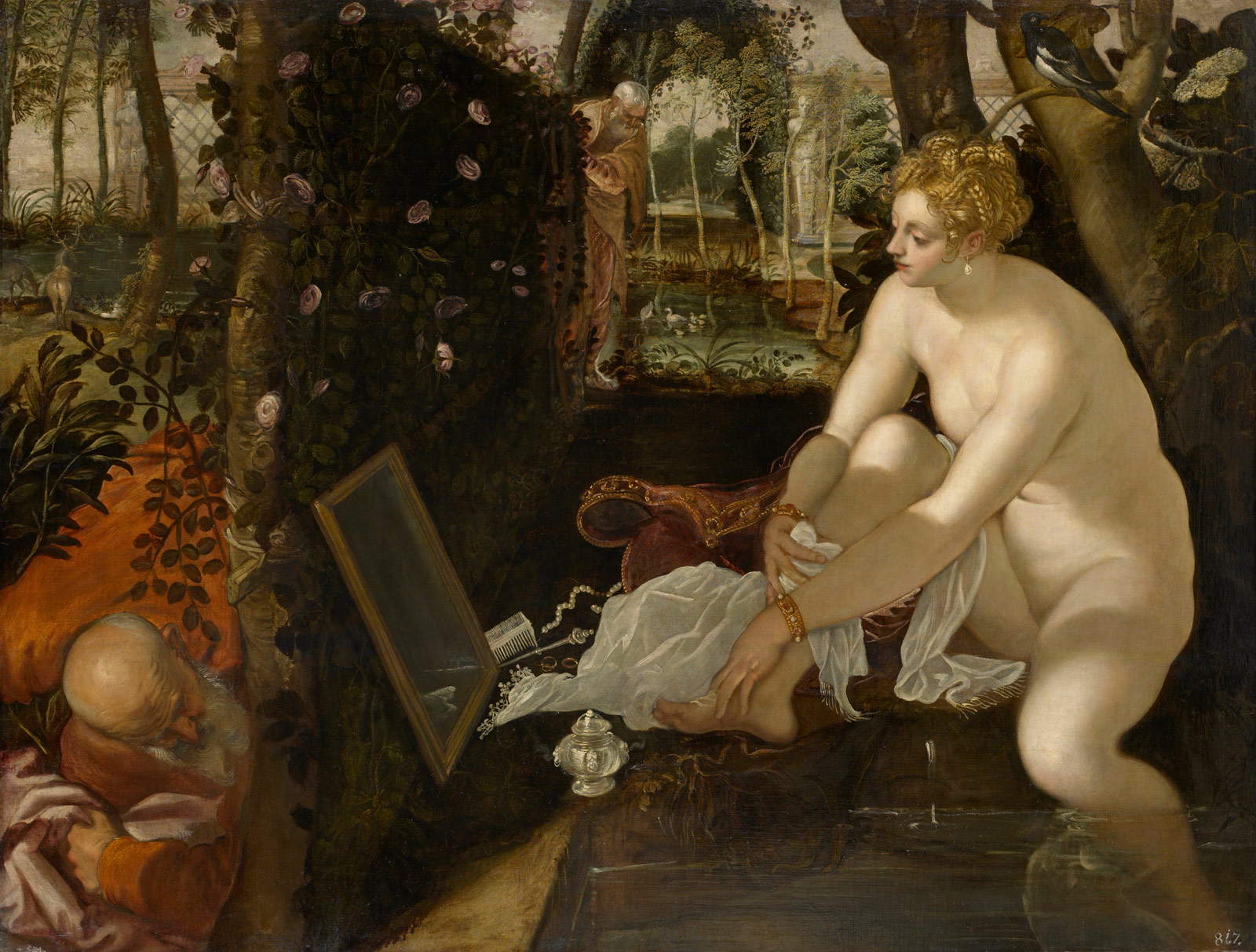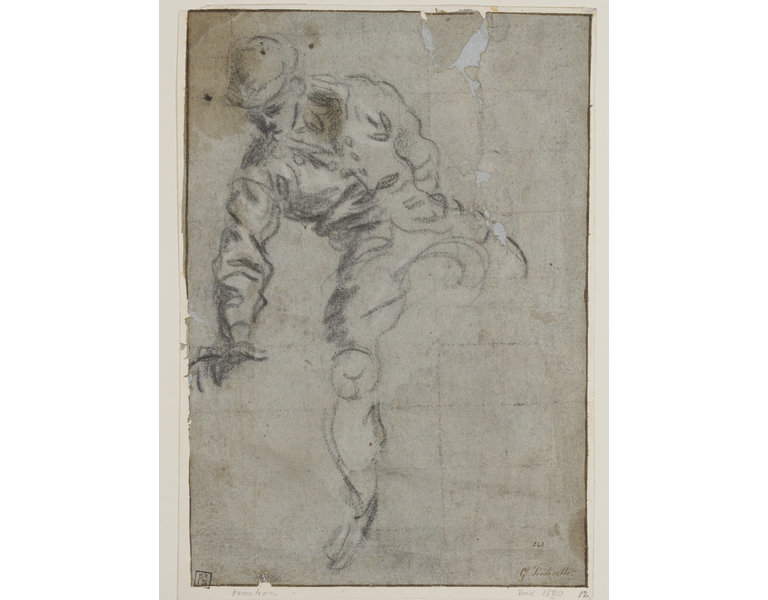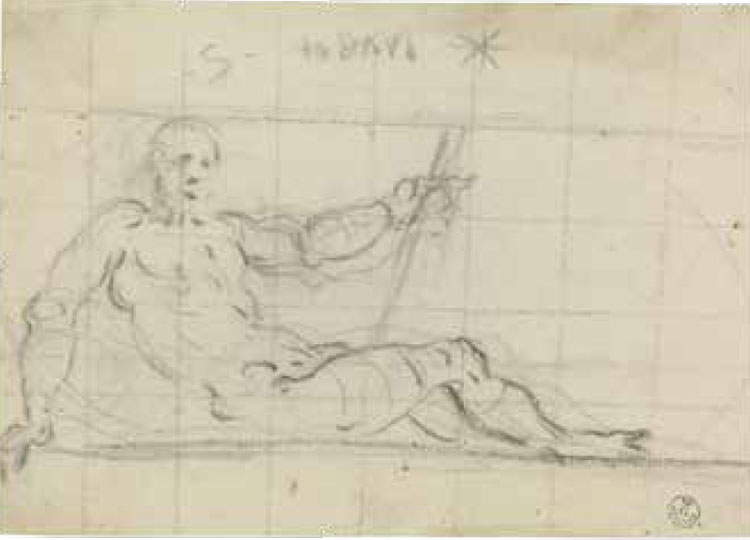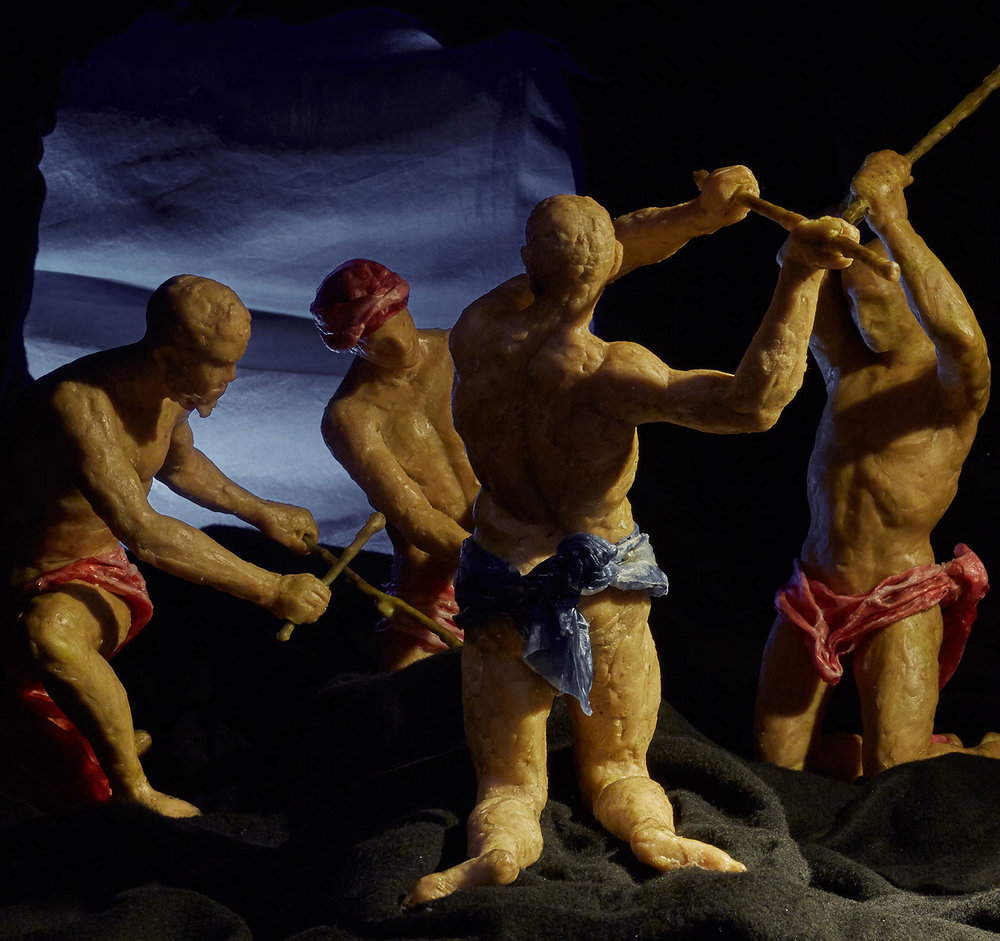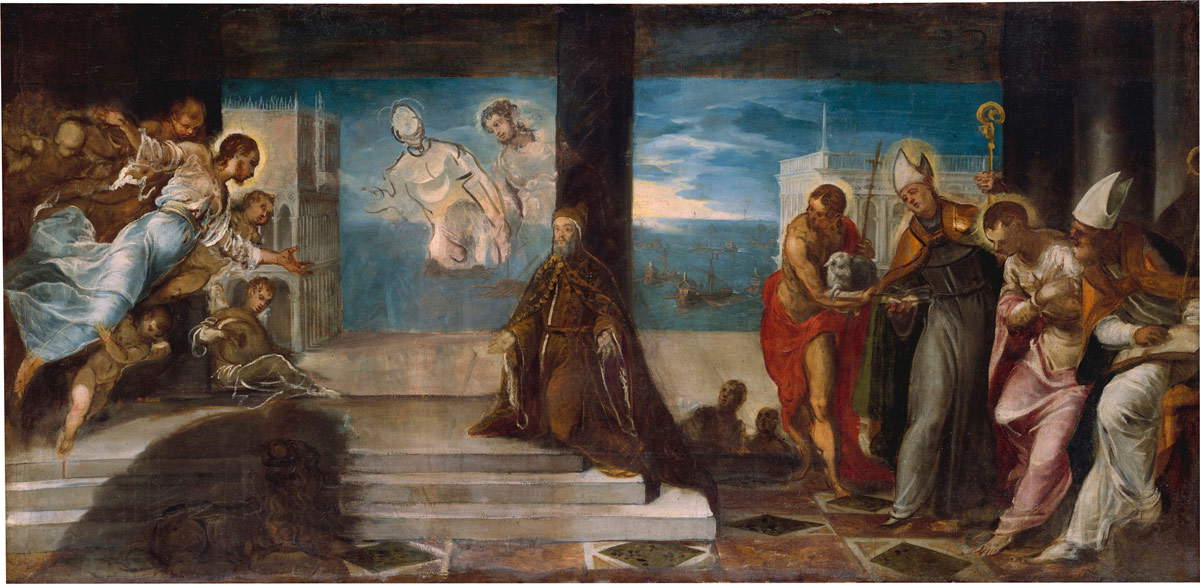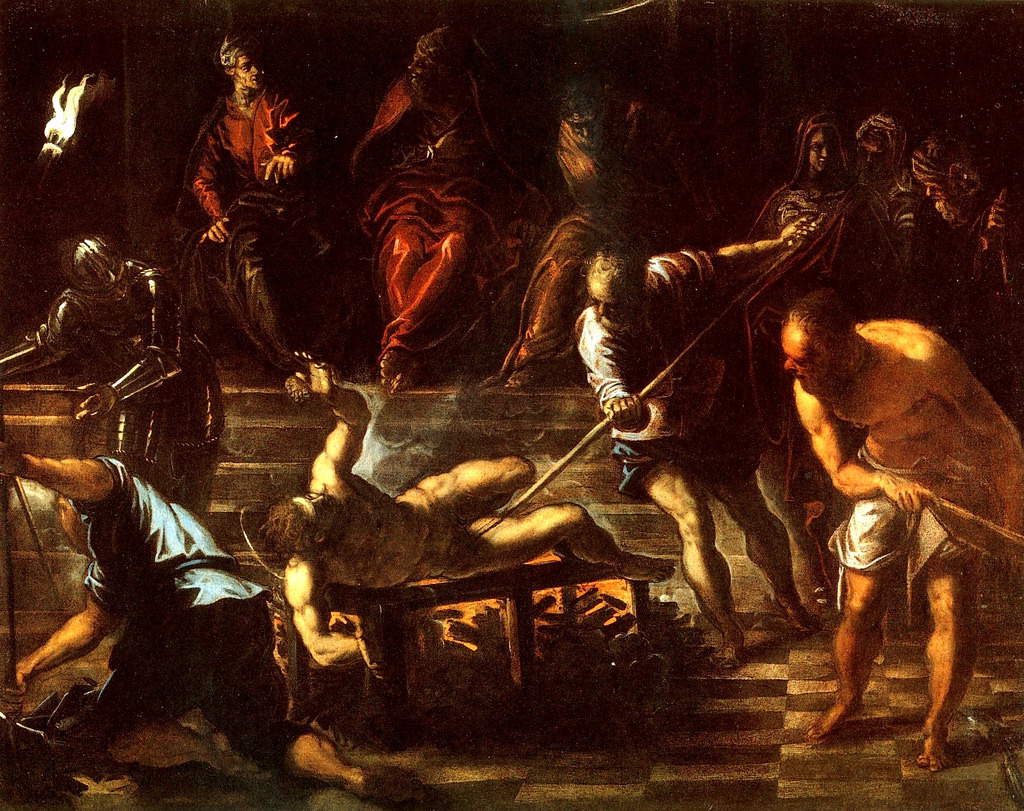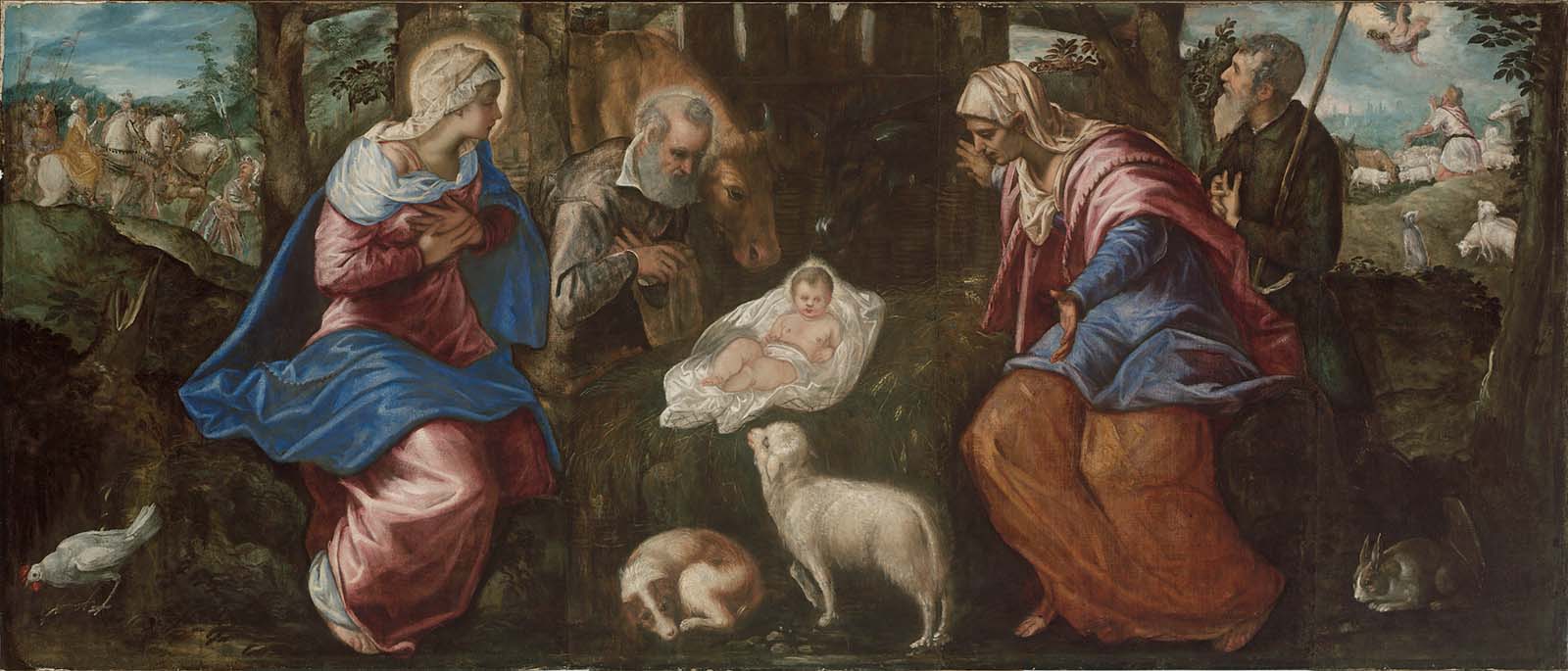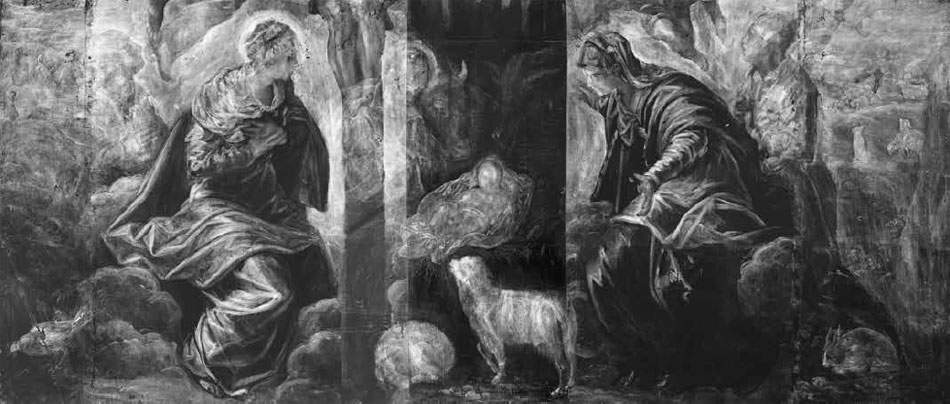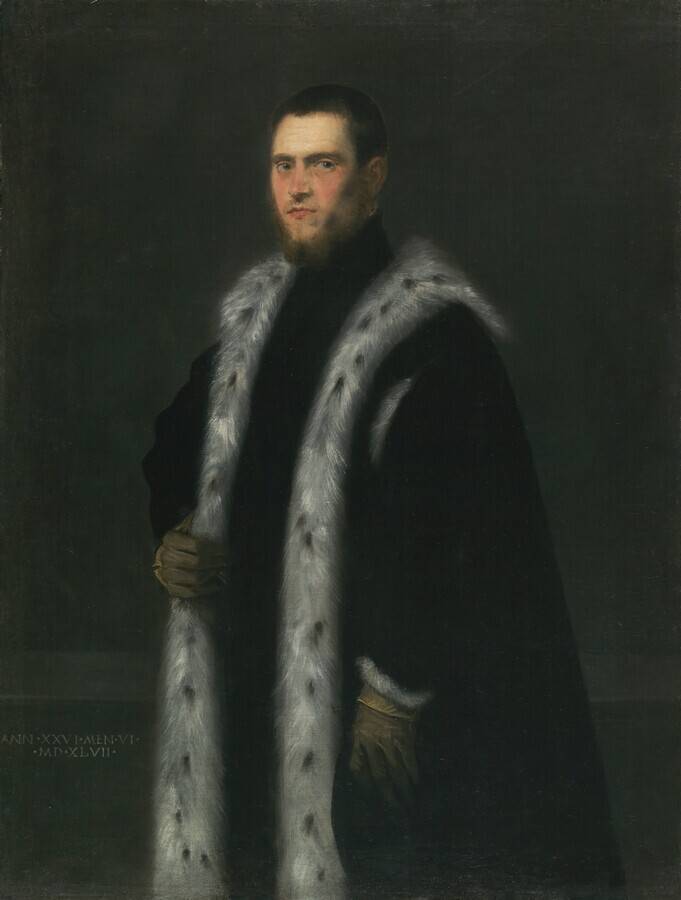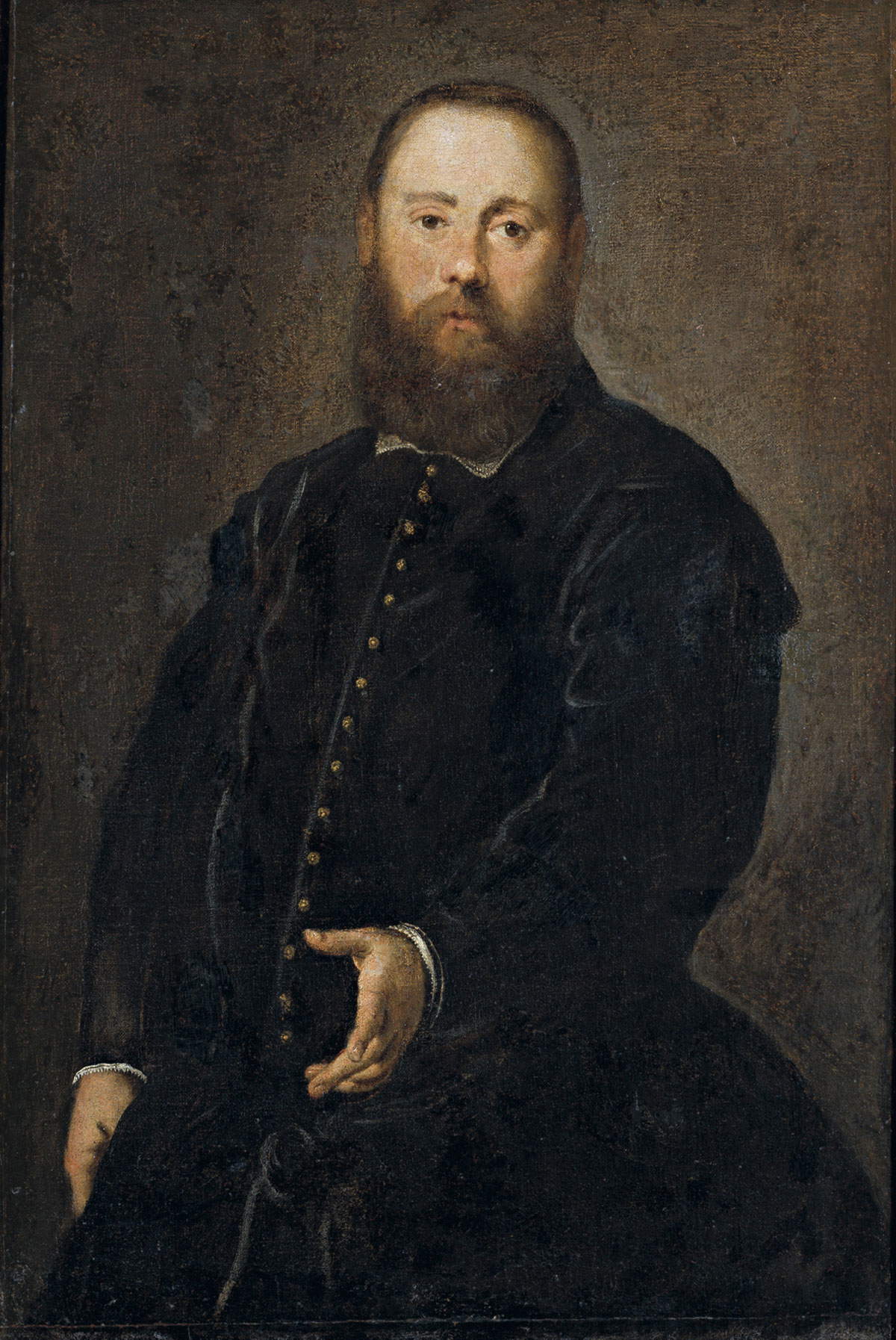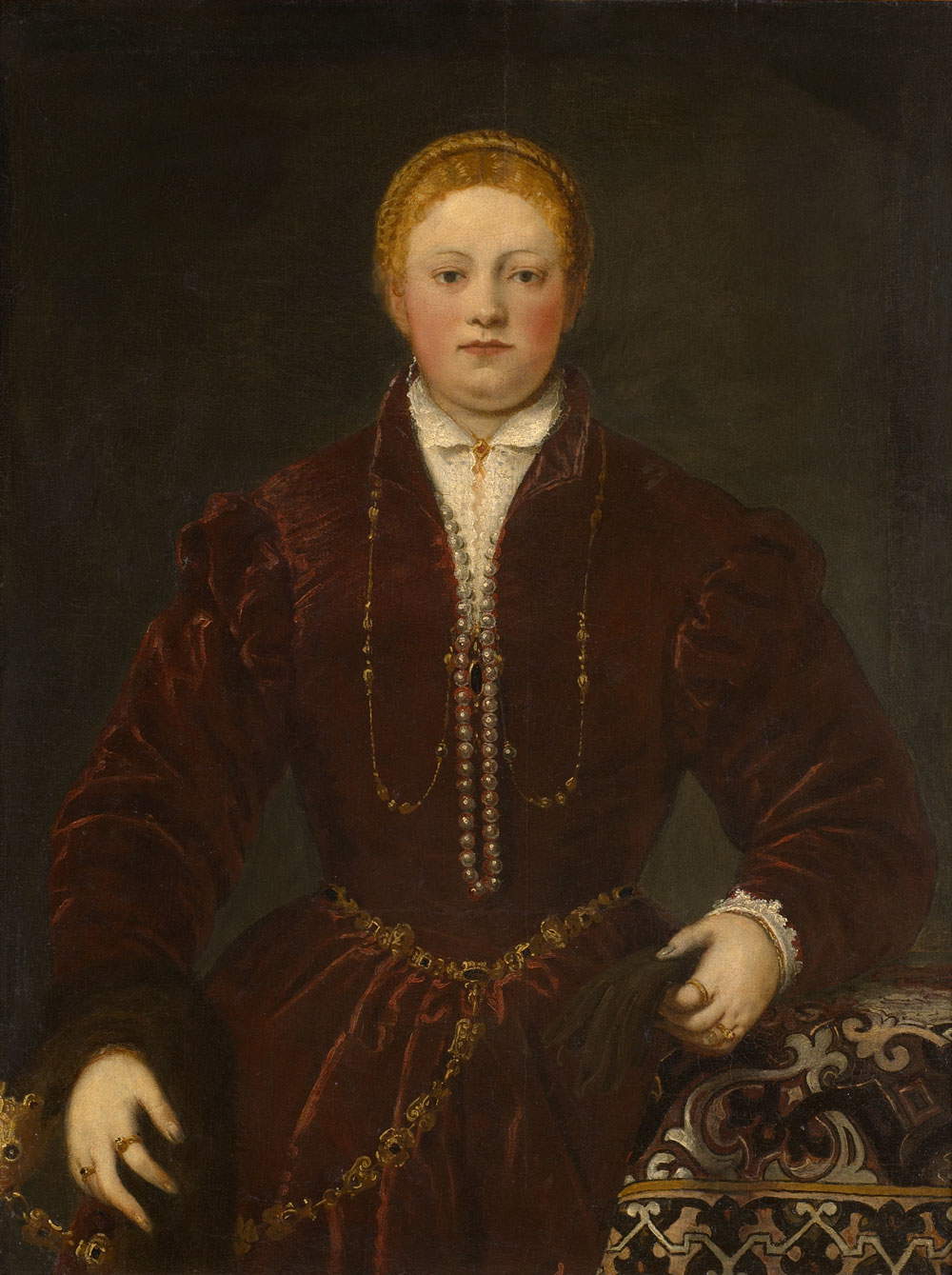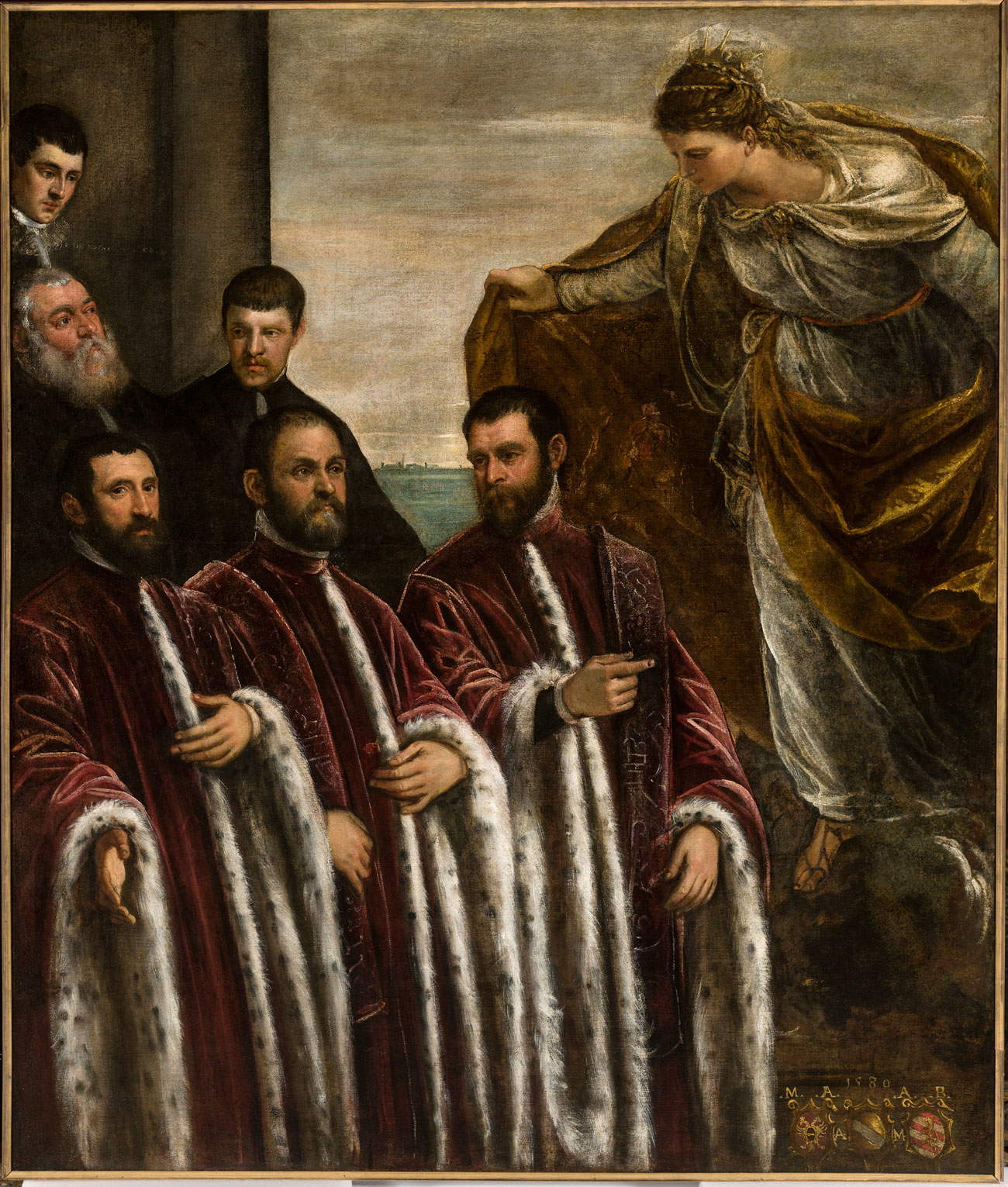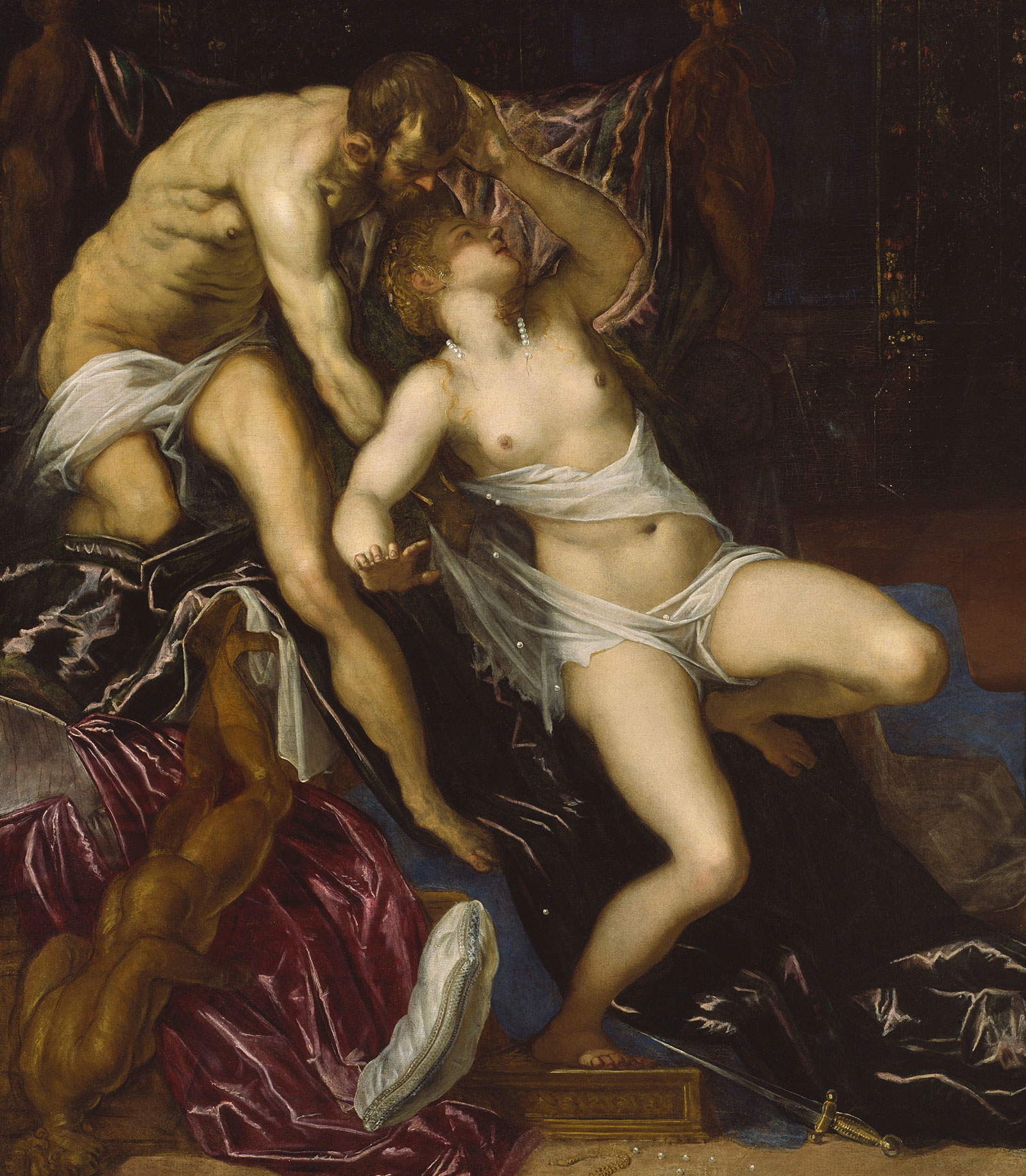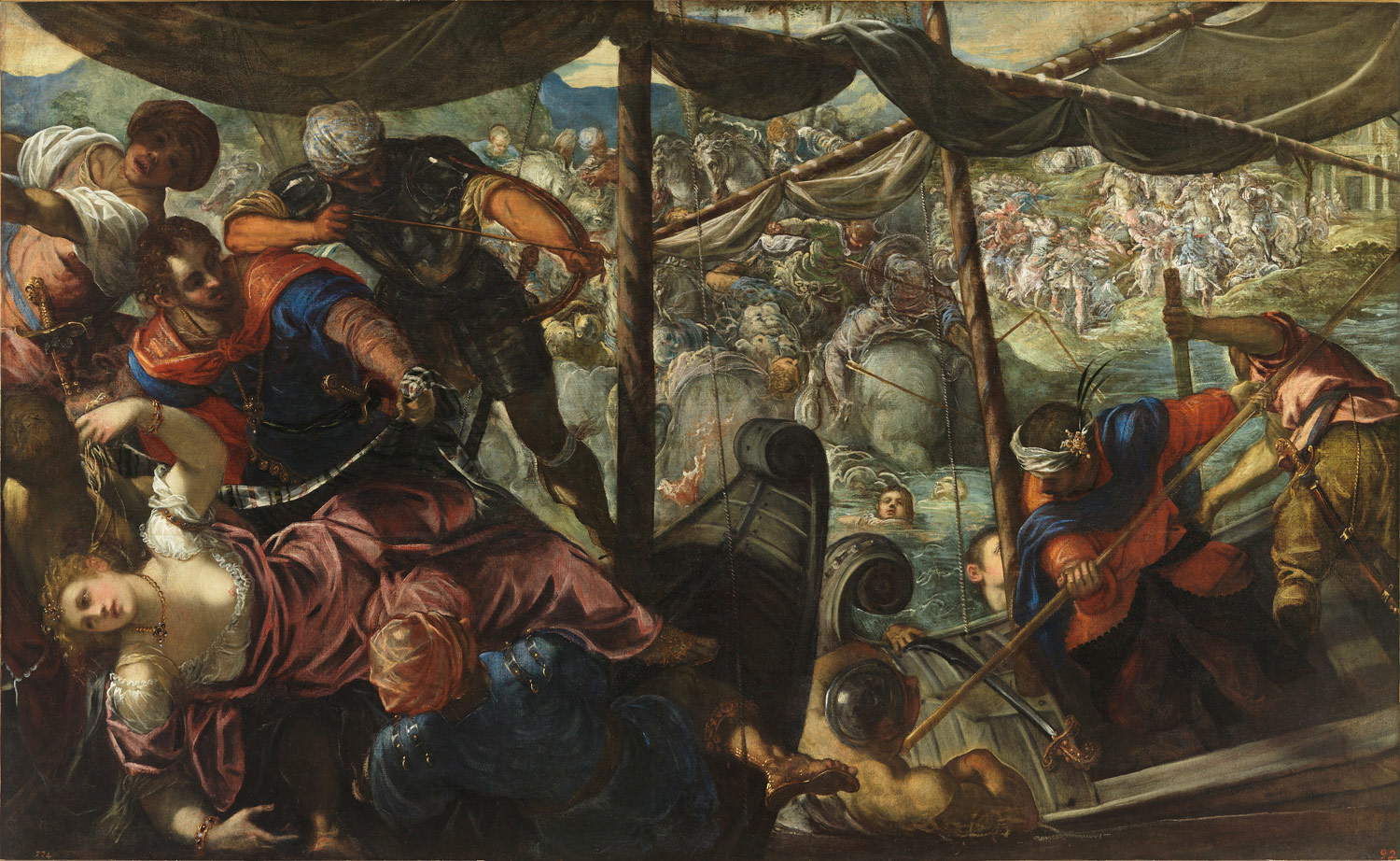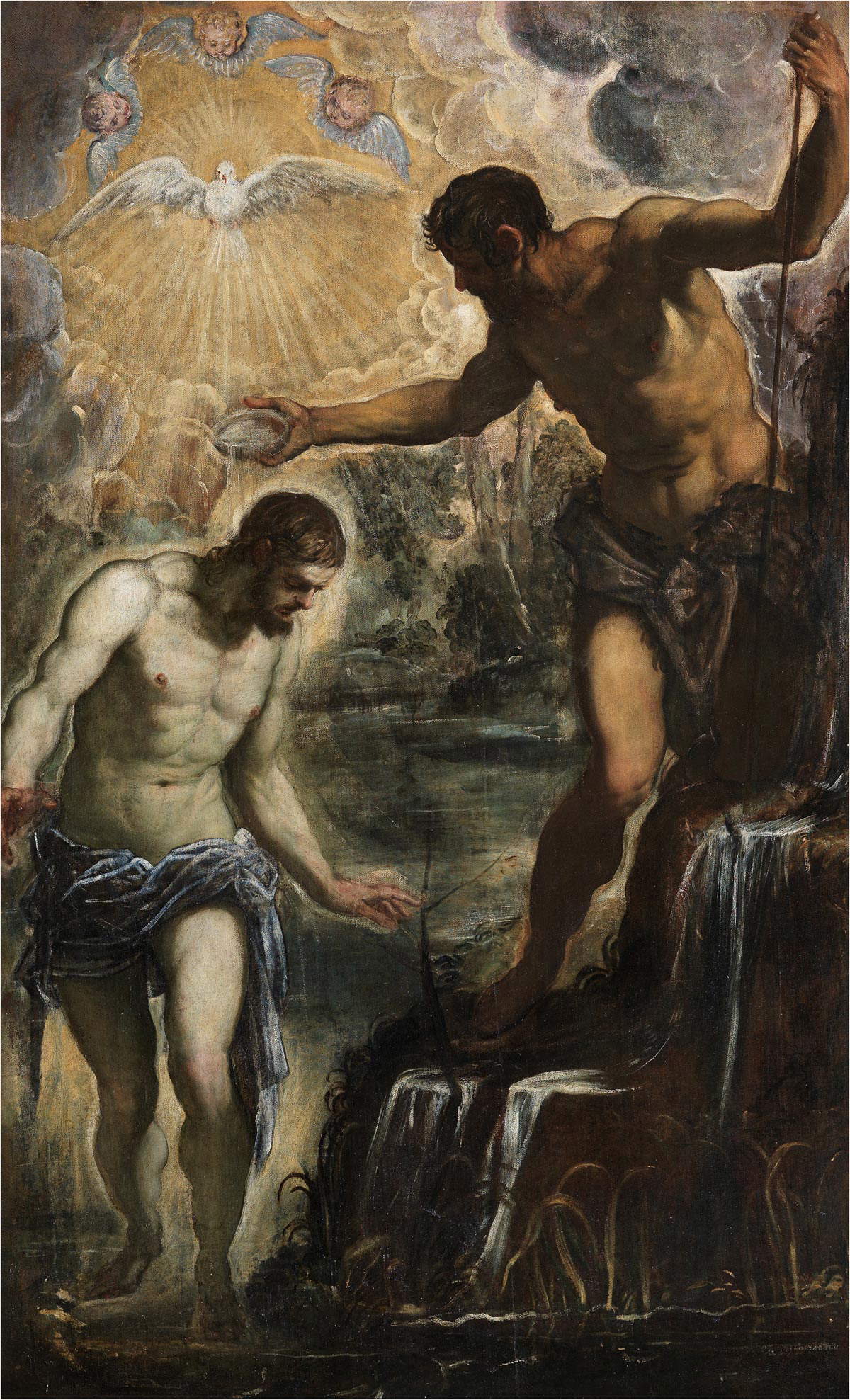by Federico Giannini (Instagram: @federicogiannini1), published on 25/01/2019
Categories: Exhibition reviews
/ Disclaimer
Review of the exhibition "Tintoretto 1519-1594" in Venice, Doge's Palace, September 7, 2018 to January 6, 2019.
No doubt hangs that the extraordinary Miracle of the Slave, the monumental canvas that Tintoretto (Jacopo Robusti, Venice, 1519 - 1594) painted in 1548 for the Scuola Grande di San Marco, represents a kind of caesura between the youthful phase of his career and the years of his maturity: and precisely at the conclusion of the exhibition on the young Tintoretto that the Gallerie dell’Accademia in Venice set up between the end of 2018 and the beginning of 2019 to celebrate the 500th anniversary of the artist’s birth, came the impressive oil on canvas that tells of the miracle performed post mortem by St. Mark, who intervened to save from torture a slave guilty only of having worshipped him, and for this condemned by his master. Two of the greatest scholars of the Venetian artist, Robert Echols and Frederick Ilchman, have called the Miracle of the Slave a turning point for the Venetian artist’s career, but also for sixteenth-century Venetian painting itself. That powerful painting that burst onto the lagoon scene shortly before the middle of the century brought with it a long sequel of novelties: a dynamism that was unprecedented, figures on a much larger scale than contemporaries were used to seeing in similar works (and foreshortened so boldly that they seemed about to leave the picture), the close dialogue with Michelangelo’s art, the highly dramatic use of light.
Here was the end of the exhibition on the young Tintoretto at the Gallerie dell’Accademia, and at the same time the exhibition Tintoretto 1519 - 1594, held at the Doge’s Palace in Venice on the same dates (i.e., from September 7, 2018 to January 6, 2019), but also strong with a second stop scheduled in Washington from March 10 to July 7, 2019 (and curated by the aforementioned Echols and Ilchman), started from here. An exhibition aimed at retracing, in its entirety, the mature phase of Tintoretto’s production: in some ways, therefore, it has been set up as a complementary exhibition to the one at the Gallerie dell’Accademia, but it is also an exhibition endowed with its own autonomy, although imagined together with the other. In the meantime, it has come after several years of work aimed at preparing a complete and up-to-date monograph on Tintoretto: it should be borne in mind that, if we disregard the exhibitions that have considered only limited aspects of the Venetian artist’s production, the last monograph that intended, on the contrary, to broaden its scope, was the one held at the Prado in 2007 (and that in turn was the first after seventy years of absence of exhibitions on Tintoretto: the most immediate previous one was the one organized in Venice in 1937), followed by the more modest one at the Scuderie del Quirinale in 2012. The Venice and Washington exhibitions then came in the wake of new discoveries (mainly documentary in nature) that helped to better frame some of Tintoretto’s important works, and it also broadened the perspective of the 2007 Madrid exhibition by going into greater focus on two major themes, namely portraiture and working techniques.
Then there is the fact that an exhibition on Tintoretto is always anexceedingly complicated affair, since most of his most pregnant works are immovable and all concentrated in the historic center of Venice: it will therefore never be possible to have an exhibition that really brings all of Tintoretto within one place. Therefore, for this reason, as well as because of the close connection between the painter and his city (Tintoretto never left Venice, and of the great Venetian painters of the mature Renaissance he was the only native of the city, since on a par with him one can place just Titian, who was from Cadore, Jacopo Bassano another painter from the hinterland, and Veronese, and that we can exclude Sebastiano del Piombo due to the fact that he spent most of his career outside of Venice), the lagoon capital can only be the ideal venue for an exhibition that sets out to make a profound reconnaissance of Tintoretto’s art.
 |
| A room of the exhibition Tintoretto 1519 - 1594 |
 |
| A room from the exhibition Tintoretto 1519 - 1594 |
 |
| A room from the exhibition Tintoretto 1519 - 1594 |
A reconnaissance that starts from one of the happiest moments of his career: the affirmation that followed the Miracle of the Slave, which had the double effect of increasing the number of commissions received by the painter, and of attracting an increasing amount of criticism from his colleagues, who ill tolerated the innovations that Jacopo Robusti had introduced even on the level of technique. It certainly cannot be denied that Tintoretto was a somewhat rapacious artist: one concern that remained constant throughout his career was to beat his rivals to the punch by dismissing as many works as possible in order to continually procure new work. In order to achieve this, Tintoretto constantly sought to minimize the execution time of his works: to this propensity we owe his very peculiar brushstroke, which “spared” on details but generated an original dynamism unprecedented in the history of Venetian painting and which ended up achieving the full involvement of the viewer. The artist, writes Roland Krischel in his catalog essay (devoted precisely to the technique), “used a free, sketchy brushstroke for the most varied purposes: for example, to save effort in the case of a work visible only from a distance or against the light; to differentiate two different levels of reality or forms of existence; to involve the viewer in a more active visual experience [...]. The rapid application of the brush - in single strokes, in spots, in brush strokes - does not allow the eye to rest, and this generates a sense of movement. But, above all, this expressive and lively brushwork attests to the artist’s emotional involvement-and communicates it to the viewer.” Such bold investigations constitute perhaps the most obvious stylistic mark of the mature Tintoretto: clear evidence of this can be seen in a painting such as the Creation of the Animals, dating from shortly after the success of the Miracle of the Slave (it can be dated to a period roughly between 1550 and 1553). Executed as part of a series of canvases for the School of the Trinity, which were intended to represent episodes from the Book of Genesis, it stands out for the strong sense of movement the artist imprinted on the figures, with the Eternal Father soaring in the air and the animals following and preceding him and seeming to want to transport him in their race, emphasized by a supernatural light (like the one that creates a halo around the little dog on the shore).
In the same room there is also room for a work such as Saint Martial in Glory between St. Peter and St. Paul, slightly earlier (it is dated 1549), but functional in introducing visitors to one of the “pivots” of Tintoretto’s criticism: that sign reading “the drawing of Michel Angelo and ’l colorito di Titiano” that according to tradition the artist would have hung on a wall in his studio as a young man. Drawing as concept and planning before the final drafting of the painting, colorito as the direct and immediate application of colors on the pictorial surface: a juxtaposition that has always been read as a kind of rivalry between reason on the one hand and the senses on the other. In the mid-sixteenth century, however, the aesthetic debate began to question whether it was not possible to unite these two opposite poles: it is likely that Tintoretto deliberately wanted to pose himself as the artist capable of reconciling the two positions by proposing an art that combined figures modeled in the manner of the Florentines and an intense, saturated color that looked directly at nature, as was that of the Venetians. The Saint Martial is a work in which this intent of Tintoretto is unmistakably discernible: the two saints sitting on thrones of clouds at the feet of Martial are reminiscent of Michelangelo not only in modeling but even in pose (they look like the prophets of the Sistine Chapel), and the coloring remains similar to that of Titian. The closeness to Michelangelo then becomes explicit as the artist directly studies the works of the great Tuscan artist (present, at the Venice exhibition, with two studî, one from Michelangelo’s Day and one from Michelangelo’s Twilight from the Medici Chapels), rendered on canvas with heroic and bursting figures, such as those of St. Andrew and St. Jerome, possible thanks to the careful analysis of sculptural models.
Equally strong and intense (although of a different kind of intensity) are the Tintoretto nudes, to which the Venice exhibition devoted an entire room. Here, too, Jacopo Robusti followed in the footsteps of a tradition that had reached its zenith in the female nudes of Giorgione and Titian: these were nudes cloaked with marked accents of eroticism, mostly set in the context of mythological or biblical subjects, which were requested to decorate private rooms. Tintoretto, in contrast to a Titian who resolved his nudes in more distinctly sensual terms, favored a more dramatic approach, changing the register from time to time: in the Old Testament scenes preserved at the Prado, Joseph and Putiphar’s wife and Judith and Holofernes, we note in the first case a scene with lascivious contours and imbued with explicit sensuality, while, in the second case, the intoxication of the Assyrian leader, which leads him to abandon himself limply on his bed, is counterbalanced by the violent determination of Judith who is about to pounce on him with her sword. This blurry boundary between different genres, Miguel Falomir has noted, becomes blurred as never before in one of Tintoretto’s best-known erotic masterpieces, Susanna and the Old Men: despite the fact that the theme was supposed to suggest moral lessons to the sixteenth-century observer (the protagonist is in fact the biblical heroine who sees her purity being undermined by two lecherous old men, who threaten to accuse her of adultery if she does not give herself to them: the situation is resolved in extremis by the prophet Daniel, who rescues Susanna before her condemnation and accuses the two slanderers by proving their deception), the relative seems almost invited to join the old men (with “the presence of the mirror,” Falomir writes, “and the deliberately opposing positions of the two voyeurs [....]” that “stimulate us to imagine the woman’s body from several points of view, arousing a meta-artistic game that must have seduced the painting’s first known owner, the French painter Nicolas Régnier”), and in the end the latter “feels ridiculous for having identified with the two concupiscent old men, figures who constituted a recurrent object of derision in certain literature of the time.” There remains no doubt, however, that the narrative character of Tintoretto’s mythological or biblical works (especially the more overtly erotic ones) remains the most distinctive feature of this area of his production.
 |
| Tintoretto, Creation of the Animals (1550 by 1553; oil on canvas, 151 x 258 cm; Venice, Gallerie dellAccademia) |
 |
| Tintoretto, Creation of Animals, detail |
 |
| Tintoretto, Saint Martial in Glory between Saint Peter and Saint Paul (1549; oil on canvas, 386 x 181 cm; Venice, Church of San Marziale) |
 |
| Tintoretto, Saint Andrew and Saint Jerome (1552; oil on canvas, 225 x 145 cm; Venice, Gallerie dellAccademia). Ph. Credit Francesco Bini |
 |
| Tintoretto, Joseph and the Wife of Putiphar (c. 15521555; oil on canvas, 54 x 117 cm; Madrid, Museo Nacional del Prado) |
 |
| Tintoretto, Judith and Holofernes (c. 15521555; oil on canvas, 58 x 119 cm; Madrid, Museo Nacional del Prado) |
 |
| Tintoretto, Susanna and the Old Men (c. 1555; oil on canvas, 147 x 194 cm; Vienna, Kunsthistorisches Museum, Gemäldegalerie) |
The next three sections of the exhibition gave the public the opportunity to embark on a singular and lengthy journey into Tintoretto’s technique: this was one of the highlights (as well as one of the most compelling) aspects of the exhibition at the Doge’s Palace. The first of the three focuses took stock of the basis from which the painter began his paintings: the study of the figure in action. Tintoretto’s interest in the human figure led him to investigate not only sculptures, as seen above, but also living models, which allowed him to capture with extreme care the anatomies and poses that would later animate the characters included in the compositions (and it was a practice that the artist never abandoned: we have documents attesting that, even in the last years of his career, Tintoretto continued to use living models). The figures were then framed in squared grids (as is evident from the Clothed Male Figure Riding on Horseback, a study for a horseman that appears in the large Crucifixion executed in 1565 for the Scuola Grande di San Rocco), which allowed the artist to obtain the scale of the final composition (the final study was functional to the direct transfer of the figure onto the canvas). Squaring was the final stage of the study: the figures were first depicted nude, then the artist proceeded to add the clothes with successive lines of pencil or chalk (this was a typical practice of Renaissance artists). This can be seen by looking at the semi-reclining Male Nude, a study for a figure for the ceiling of the Scuola Grande di San Rocco, where with a few pencil strokes the armor that the figure would wear in the final drafting of the work is suggested. Only at the end was the grid added.
However, the artist did not employ only the medium of drawing to study his compositions. One of Tintoretto’s most unique techniques was the use of miniature theaters on which he arranged articulated wooden figurines, arranging them in the poses that the characters would assume in the finished painting (we know this because there are explicit references to this practice in some drawings). In doing so, the painter had a way to study the effects of light and the way the figures would interact with each other in the context of the painting. Turning then toexecution (the second of the three focuses devoted by the Venetian review to Tintoretto’s technique), the painter sketched his figures on an imprimitura that was often already colored so as to shorten the time required for execution: moreover, sand was often added to the imprimitura so that the surface would be rougher, another expedient to save on working time. The working method was, in essence, similar to that of a fresco painter who worked on the individual sections of a scene (in Tintoretto’s case, on individual figures): we have an example of this if we look at the sketch with The Doge Alvise Mocenigo presented to the Redeemer, where some figures such as those on the right are already almost finished, others (such as the doge himself) appear to be in an advanced state of completion, while others are barely sketched.
The last of the three in-depth studies focused on the practice of reuse, another stratagem that the artist employed in order to be as quick as possible and thus procure more and more work. Reuse in Tintoretto’s workshop was twofold: on the one hand, studies of figures were used for several paintings, as evidenced by the Martyrdom of St. Lawrence from a private collection, a work in which the figure of the martyr saint is in the same pose assumed by the Helen of Troy protagonist of the Rape of Helen now in the Prado Museum (these are works made in the same period, i.e., the mid-1970s). On the other hand, Tintoretto did not shy away from recycling paintings that were no longer usable: through certain tricks, works that had already been made and for various reasons had become unserviceable (for example, due to damage or waste) could be transformed into different paintings, even with a different subject. One of the most striking cases is the Nativity preserved at the Museum of Fine Arts in Boston: X-rays have revealed that Tintoretto used two fragments of an earlier Crucifixion, presumably a Magdalene and a Madonna, transforming them into a Virgin and a St. Anne respectively by means of insertion into a later painting composed of five pieces of canvas joined by vertical ribs.
 |
| Tintoretto, Clothed Male Figure Straddling a Horse (1565; charcoal with white highlights on squared azure paper, recto; 312 x 221 mm; London, Victoria and Albert Museum) |
 |
| Tintoretto, Semi-reclining Male Nude (1564; black chalk on white squared paper, 210 x 298 mm; Florence, Gallerie degli Uffizi, Gabinetto Disegni e Stampe) |
 |
| Cristina Alaimo, Federica Cavallin, Model returned from Tintoretto’s “La Fucina di Vulcano” (2018; beeswax and silk, wood box, cloth and silk). Ph. Credit Cristina Alaimo |
 |
| Tintoretto, The Doge Alvise Mocenigo Presented to the Redeemer (15711574; oil on canvas, 97 x 198 cm; New York, The Metropolitan Museum of Art, John Stewart Kennedy Fund) |
 |
| Tintoretto, Martyrdom of St. Lawrence (c. 1575; oil on canvas, 94 x 118 cm; Private collection) |
 |
| Tintoretto, Nativity (c. 1571 with reuse of earlier figures; oil on canvas, 156 x 358 cm Boston, Museum of Fine Arts, gift of Quincy A. Shaw) |
 |
| Tintoretto, Nativity, x-ray |
After a section devoted to Tintoretto, who, after the death of Titian, became the most celebrated and sought-after painter of the Serenissima (and who in many works seems to embrace the lyricism of the older master), here presents before the public the long corridor devoted to portraiture, one of the main reasons for interest in the exhibition, given the breadth and variety of the examples that the curators have arranged along the way. In the area of Tintoretto portraiture, the exhibition pursued two main objectives: first, to present only works of high quality, thus going to some extent to obliterate the selections of past exhibitions that, according to the curators, had the fault of including works that were far from excellent, and attributable to the painter’s followers (the revision of Tintoretto’s catalog with consequent narrowing, whether agreeable or not, is a point on which Echols and Ilchman, moreover, have long insisted). The second: to demonstrate, through an itinerary capable of exhibiting some of Tintoretto’s most important portraits in strict chronological order, that in this sphere Jacopo Robusti ranks on a par with the greatest portrait painters of his time (although, on the contrary, his production in this genre has often not enjoyed the consideration that has been reserved for other themes in his painting). And that the exhibition wanted to give considerable weight to portraiture can also be inferred from the fact that Echols and Ilchman decided to open and close it with two self-portraits of the painter (the first capturing him at a young age, the other executed in old age), not least because Tintoretto’s self-portraits themselves say a great deal about how the artist saw himself, that is, as an artist who, unlike Titian, aspired to establish a direct relationship with the viewer, and who in order to achieve this goal did not care about appearances: that is, there are no elements that hint at his status, although at the time the two paintings were made Jacopo Robusti was already an established artist, who could well afford to pass on a lofty image of himself. If anything, we are in front of the self-portraits of an energetic artist, who with determination sought “to always push himself further, to go beyond the limits imposed by conventions, all elements in agreement with what we know about the painter thanks to the words of his contemporaries and early biographers” (Echols and Ilchman).
The main novelty of the exhibition consists precisely in the attempt at a critical repositioning of Tintoretto’s portraiture: the assumption is that the artist deserves, the curators write, “to be considered one of the greatest portrait painters of the 16th century, while admitting, however, that this judgment is based on a limited number of autograph works.” The painter often adopted the usual formula: the subject is turned three-quarters and looks as if he has just turned around (Tintoretto’s portraits give us a strong impression of movement and vitality), he emerges from a somber background, and there are not too many elements to distract the viewer’s attention from the face of the person depicted. Eyes and hands are the parts of the body on which the artist wants us to place our gaze: after all, with his large canvases with religious or mythological subjects, Tintoretto aimed to emotionally engage the viewers, and the same is true of the portraits. See, for example, the expressions ofMan at the Age of Twenty-six orMan with a Golden Chain, all of them, moreover, admirable masterpieces animated by great spontaneity and a high degree of naturalism: for Echols and Ilchman, the true greatness of Tintoretto’s portraiture lies precisely in his approach aimed at appealing to the ephemeral rather than the eternal. In other words, traditionally the portrait had the function of handing down the image of the subject: Jacopo Robusti, with his experiments that were aimed at seeking a kind of dialogue between subject and relative, fixed the protagonist of the painting in a moment and made him perceptible, close, somehow present. Even, in a masterpiece like the Portrait of a Young Man of the Doria Family this presence becomes almost concrete, with the character seeming to step outside the physical limits of the painting with the gesture of his hand outstretched toward the viewer and his lips tightened to utter a word, as if he were speaking to us. These characteristics seem to be lacking in the female portraits, which, according to Echols and Ilchman, are almost never up to the standard of their male counterparts: perhaps, too direct an approach would have fallen short of the demands of decorum necessary for the portrait of a woman of good character. There are exceptions, however, such as the Portrait of a Woman in Red with its exuberant attire and firm, confident stare before her. The artist then did not fail to make group portraits (an example is Saint Justina with three treasurers and their secretaries, made in 1580 in collaboration with her son Domenico), but these did not reach the level of individual portraits.
Almost as a coda to the gallery reserved for portraits, the exhibition devoted a room to the theme of movement in Tintoretto: the eloquent title of the section, The Suspended Instant, was intended to emphasize the fact that many of Jacopo Robusti’s paintings, especially those with a narrative character, capture action at a very specific moment. As in a photographic snapshot: imagining the painter in the setting in which the story takes place, we could say that if he had arrived just one or a few seconds later, a completely different scene would have presented itself before him. Such is the case in Tarquinius and Lucretia, one of the Venetian artist’s most powerful paintings, in which the rape takes place in a frantic moment and where the extreme violence of the moment (demonstrated not only by Tarquin’s brutality, but also by the detail of the statue falling to the ground, which well helps us to immerse ourselves in the scene) is mixed with the eroticism suggested by Lucretia’s naked body: this is another of Tintoretto’s paintings in which the boundary between different genres is blurred (indeed, it is perhaps the most obvious example in some ways). So it is then in The Rape of Helen, where the main episode, the abduction of the mythological wife of Menelaus, takes place while a fierce battle rages. From mythology to religion, Tintoretto 1519 - 1594 gave the conclusion to the theme of the painter’s reception of the dictates of the Counter-Reformation: in a late painting, the Baptism of Christ executed for the church of St. Sylvester, Tintoretto continued to innovate by proposing two impetuous, overflowing figures, and the gesture of Jesus’ right hand reaching forward (consider that the work was intended to be placed above an altar) has been read as an allusion to the Eucharistic sacrament and thus to the doctrine of transubstantiation that the Church intended to reaffirm after the rejection of the Lutherans, who did not recognize the conversion of the consecrated host into the substance of Christ’s body. The exhibition’s thesis, supported by Tintoretto’s commitment to religious commissions, even the less important ones, is that the artist had adhered to the message of the Counter-Reformation not out of convenience, but in a sincere and spontaneous manner: thus, according to this reading, his religious paintings would take on the connotations of devout acts of faith.
 |
| Tintoretto, Self-Portrait (c. 15461547; oil on canvas, 45 x 38 cm; Philadelphia Museum of Art, gift of Marion R. Ascoli and the Marion R. and Max Ascoli Fund, in honor of Lessing Rosenwald) |
 |
| Tintoretto, Self-Portrait (c. 1588; oil on canvas, 63 x 52 cm; Paris, Musée du Louvre, Département des Peintures) |
 |
| Tintoretto, Portrait of a Man at the Age of Twenty-six (1547; oil on canvas, 130 x 98 cm; Otterlo, KröllerMüller Museum) |
 |
| Tintoretto, Portrait of a Man with a Golden Chain (c. 1560; oil on canvas, 104 x 77 cm; Madrid, Museo Nacional del Prado) |
 |
| Tintoretto, Portrait of a Young Man of the Doria Family (c. 1560; oil on canvas, 107 x 73 cm; Madrid, Museo Cerralbo) |
 |
| Tintoretto, Portrait of a Woman in Red (c. 1555; oil on canvas, 98 x 75 cm; Vienna, Kunsthistorisches Museum, Gemäldegalerie) |
 |
| Tintoretto, Santa Giustina with Three Treasurers and Their Secretaries (1580; oil on canvas, 217 x 184 cm; Venice, Gallerie dellAccademia, on deposit at Museo Correr) |
 |
| Tintoretto, Tarquin and Lucretia (c. 1578 1580; oil on canvas, 175 x 152 cm; Chicago, The Art Institute of Chicago, Art Institute Purchase Fund) |
 |
| Tintoretto, Rape of Helen (c. 15761577; oil on canvas, 186 x 307 cm; Madrid, Museo Nacional del Prado) |
 |
| Tintoretto, Baptism of Christ (c. 1580; oil on canvas, 283 x 162 cm; Venice, Church of San Silvestro) |
The differences with the exhibition on the young Tintoretto at the Gallerie dell’Accademia are many and easily discernible. These were two exhibitions sustained by two practically opposite types of approach: more philology at the Accademia, more popularization at the Doge’s Palace, with the consequence that the second exhibition was certainly easier than the first, even for the curators (in an exhibition with a philological slant, a painting is irreplaceable, which is not the case in a mostly popularized exhibition: not to mention that then, at the Doge’s Palace, a discourse sketched out in certain rooms would have been fitting in other sections as well, and above is the example of the Tarquin and Lucretia that would not have been out of place in the section on “intimacy,” just as the Judith and Holofernes would have figured well in the penultimate section). Moreover, the exhibition at the Doge’s Palace counted only on paintings by Tintoretto: thus, the comparison with other artists (though still recalled) was lacking, but the absence was compensated by some very convincing sections, starting with those on technique and portraiture where, as mentioned, the most interesting points of the entire exhibition were concentrated. The critical reinterpretation of portraiture, whether one wants to welcome it or find it questionable, is probably the only relevant new feature (excluding, it is understood, the presentation of the latest restorations: several works that have undergone interventions in view of the exhibition, and among them is the San Marziale), and it can well be said that the curators have presented themselves at the appointment with the celebrations of Tintoretto’s five-hundredth anniversary with a scientifically solid exhibition that had its greatest strength in a clear, rigorous and excellently structured informative itinerary, which literally accompanied the public inside Tintoretto’s paintings. Particularly noteworthy were the continuous and timely cross-references between drawings and paintings, and the effective reconstruction of the artist’s creative process, which made use of examples of the highest level. In Washington, everything described above will be repeated, albeit with an enlarged selection of works: this is, after all, the first time that the Venetian artist is the subject of a monographic exhibition in the United States, where many of his paintings are now preserved.
A final note, finally, on the exhibition catalog, compiled in a rather unusual form: the catalog lacks the files of the works (in their place is a more agile registry with brief comments, information on the provenance and selected bibliography: moreover, the list is not even ordered on the basis of how the works are presented in the exhibition, but follows a simple chronological criterion), and much more space has been given to the critical contributions, which cover a very broad span of Tintoretto’s career and production. The result is therefore a book on the artist that, while on the one hand prevents the reader from reconstructing the path of the exhibition (also because in the essays the works on display alternate with those that are not present), at the same time offers an interesting and in-depth overview of the painter, also suitable for a wide audience.
Warning: the translation into English of the original Italian article was created using automatic tools.
We undertake to review all articles, but we do not guarantee the total absence of inaccuracies in the translation due to the program. You can
find the original by clicking on the ITA button. If you find any mistake,please contact us.
